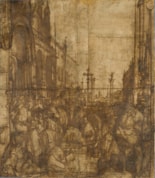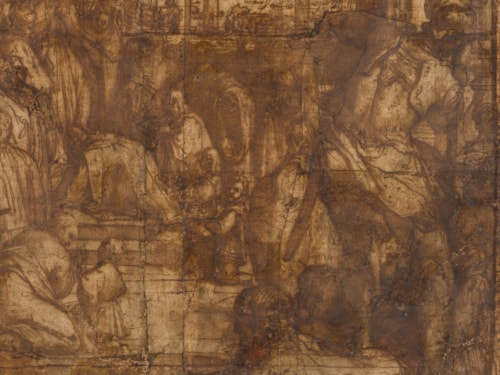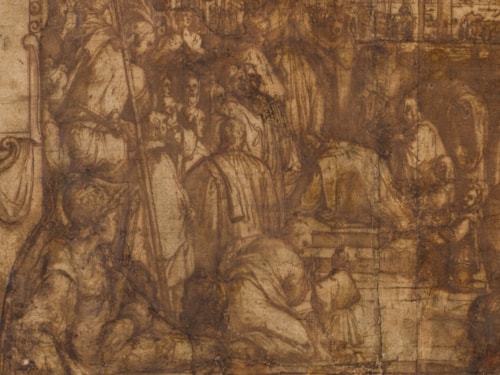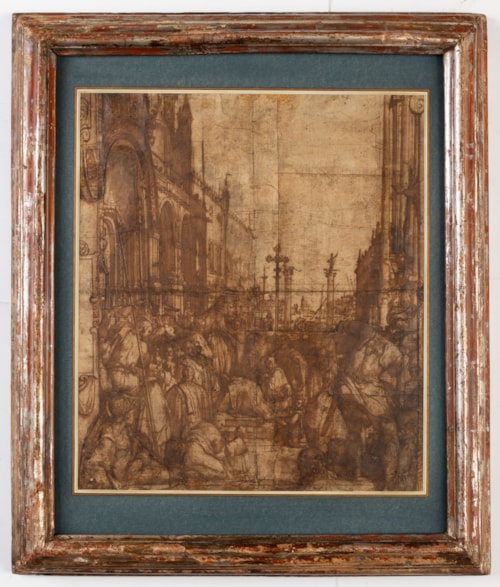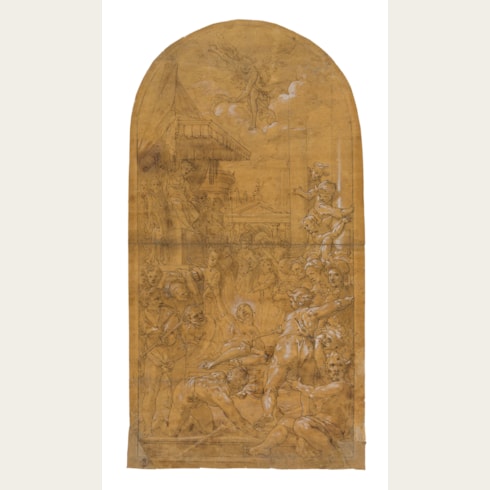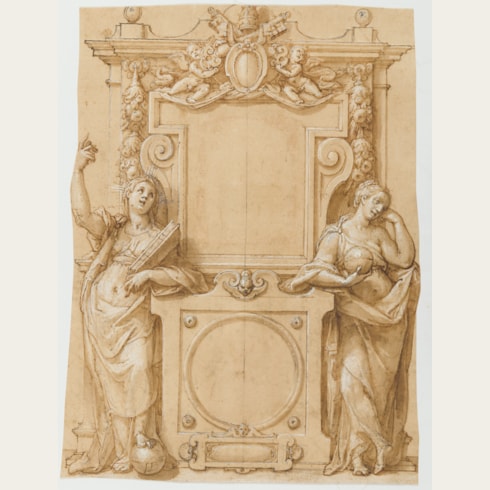Federico ZUCCARO
(Sant’Angelo in Vado c.1540/41 - Ancona 1609)
The Submission of the Emperor Frederick Barbarossa before Pope Alexander III in Venice
Numerous additions and corrections inserted by the artist into the composition on separate pieces of paper.
528 x 458 mm. (20 3/4 x 18 in.)
The event depicted in this drawing took place in front of the Basilica of San Marco in Venice in July 1177 and marked the reconciliation of the Holy Roman Emperor and the Pope after a long period of conflict between the two men, arising from the Pope’s excommunication of Frederick in 1160. Following the capture of the Emperor’s son Otto by the Venetian fleet, Doge Sebastiano Ziani was able to bring Pope Alexander III and the Emperor Frederick Barbarossa together in Venice to establish peace. Zuccaro’s canvas depicts the Pope standing beneath a baldacchino or canopy in front of San Marco, his foot on the neck of the prostrate Emperor, who kisses the Pope’s other foot, and shows the Piazzetta beyond and the island and church of San Giorgio Maggiore in the distance.
The present sheet is quite close to the composition of the final canvas, although it displays numerous pentiments and, in particular, alters the length of the façade of the Palazzo Ducale. As the scholar Roger Ward has noted, this large drawing is ‘of great historical importance [and] technical complexity…It is vital to an understanding of the function of this drawing to realise that it was not made on a single sheet, but on several smaller pieces of paper that have been joined. Furthermore, some figures or whole groups of figures were drawn on separate fragments and then, like giant pentimenti, stuck down onto the principal sheet (perhaps most easily discernible in reproduction is the soldier seated in the bottom left corner). Also the Doge’s Palace was significantly altered by bleeding out most of its visible extension beyond the façade of San Marco. In other words, this drawing, though made well beyond the invenzione stage, is nevertheless a record of work still in progress.’ Indeed, the present sheet allows for a fascinating insight into Zuccaro’s artistic process as he developed the crowded composition of this significant public commission.
Several other preparatory drawings by Federico Zuccaro for The Submission of Emperor Frederick Barbarossa before Pope Alexander III have survived. Perhaps the earliest drawing related to the project is a large horizontal composition that appeared at auction in 2010, which depicts the scene within an elaborate architectural setting, viewed from the Piazzetta with the Torre dell’Orologio in the background and San Marco at the right of the scene. However, the drawing’s horizontal orientation would have been quite unsuitable for the narrower vertical space intended for the painting. It has been suggested, therefore, that the drawing may represent a first idea by Federico for the composition, drawn either before he knew precisely the dimensions of the space to be painted, or perhaps as an attempt to persuade the Senate to allow him to decorate a much larger, horizontal space in the Sala del Maggior Consiglio. The next drawing in the sequence is an elaborate compositional study in the Pierpont Morgan Library in New York, which likewise differs from the final painting in showing the scene from the other side, looking towards the Torre dell’Orologio with the façade of San Marco at the right.
Each of the other known compositional drawings by Zuccaro for The Submission of Emperor Frederick Barbarossa before Pope Alexander III depict the scene as it was actually painted; that is, looking towards the lagoon with the façade of San Marco at the left edge of the composition. It is not known why the artist reversed the orientation of the scene, but James Mundy has suggested that it may have been because Zuccaro’s painting was to hang next to a large work by Palma Giovane in which the composition is directed to the left, and therefore to balance it the artist decided to orient his picture to the right. A compositional study in pen and ink for The Submission of Emperor Frederick Barbarossa before Pope Alexander III is recorded in a private English collection in 1970, while another compositional drawing, formerly in the collections of Everard Jabach, Pierre Crozat, Pierre-Jean Mariette and, more recently, Juan de Beistegui, is today in the Musée des Beaux-Arts in Lille. A third, highly finished drawing, very close to the present sheet in composition and slightly larger, is in the collection of the J. Paul Getty Museum in Los Angeles. A preparatory drawing for the group of spectators at the left edge of the composition is in the Statens Museum for Kunst in Copenhagen, while a handful of chalk studies for individual figures in the painting are also known. A studio copy of either the present sheet or the closely related Getty drawing is at Christ Church in Oxford.
During an earlier visit to Venice, between 1563 and 1565, Zuccaro had made a drawn copy, in red and black chalk, of Tintoretto’s recently-completed painting of Frederick Barbarossa Submitting to the Schismatic Pope Vittore IV, painted between 1562 and 1564 for the Sala del Maggior Consiglio but destroyed by fire in 1577; Zuccaro’s drawing is today in the Pierpont Morgan Library in New York. A number of details from Zuccaro’s drawn copy of Tintoretto’s lost work would later find their way into his own painting of The Submission of Emperor Frederick Barbarossa before Pope Alexander III for the same large room in the Palazzo Ducale.
Federico Zuccaro was among the most well travelled artists of his day. Unlike Taddeo, he travelled throughout Italy, working in Venice, Florence, Orvieto, Bologna, Urbino, Pavia, Turin, Parma and Mantua, while also visiting France, the Netherlands and England between 1574 and 1575. On his return he received a commission to complete the decoration of the cupola of the Duomo in Florence, begun by Vasari and completed by Zuccaro between 1576 and 1579. The next year he was back in Rome, contributing to the decoration of the Cappella Paolina of the Vatican, before departing for Venice, where he worked between 1582 and 1584. He established a particular practice of making drawings after works of art that he saw on his journeys; a sort of visual travel diary that attests to a broad and wide-ranging interest in the different schools of painting in Italy. (As the Zuccaro scholar James Mundy has noted, ‘Federico was completely without prejudice in his omnivorous ingestion of the work of other artists, both past and present.’) In 1585 he was summoned by Philip II to Spain, where he painted eight canvases for the retablo mayor, or high altar, of the Basilica of San Lorenzo at El Escorial, as well as cloister frescoes in the attached monastery. Elected the first principe of the reorganized Accademia di San Luca in 1593, Zuccaro continued to receive important commissions late into his career. He built a fine palace for himself in Rome, now the home of the Biblioteca Hertziana. Near the end of his career he wrote an artistic treatise entitled L’idea de’ pittori, scultori et architetti, published in 1607.
A gifted draughtsman, Federico Zuccaro was much influenced by the drawings of his elder brother, particularly early in his long career. However, as Julian Brooks has noted, ‘Federico’s style was less dramatic than Taddeo’s, and he answered the demands of the Catholic Church for a clearer, more iconic art. His drawings and compositions are tidier than those of Taddeo, with less robust figures, a greater interest in decorative effects, and occasionally complex iconography.’ Furthermore, Federico’s peripatetic career, together with his inveterate copying of the work of other artists, exposed him to a wider range of artistic influences, which often found their way into his drawings and paintings. As Mundy has pointed out, ‘Whereas it would be fair to say that Taddeo’s style was invented in Rome, Federico’s was forged in an international crucible…The wide stylistic range of drawings might be expected but it still, at times, surprises the viewer.’
Provenance
Ian Woodner, New York
Thence by descent until 1992
The posthumous Woodner sale, London, Christie’s, 7 July 1992, lot 18
Anonymous sale, London, Sotheby’s, 22 April 1998, lot 27
James Fenton, New York.
Literature
Exhibition


